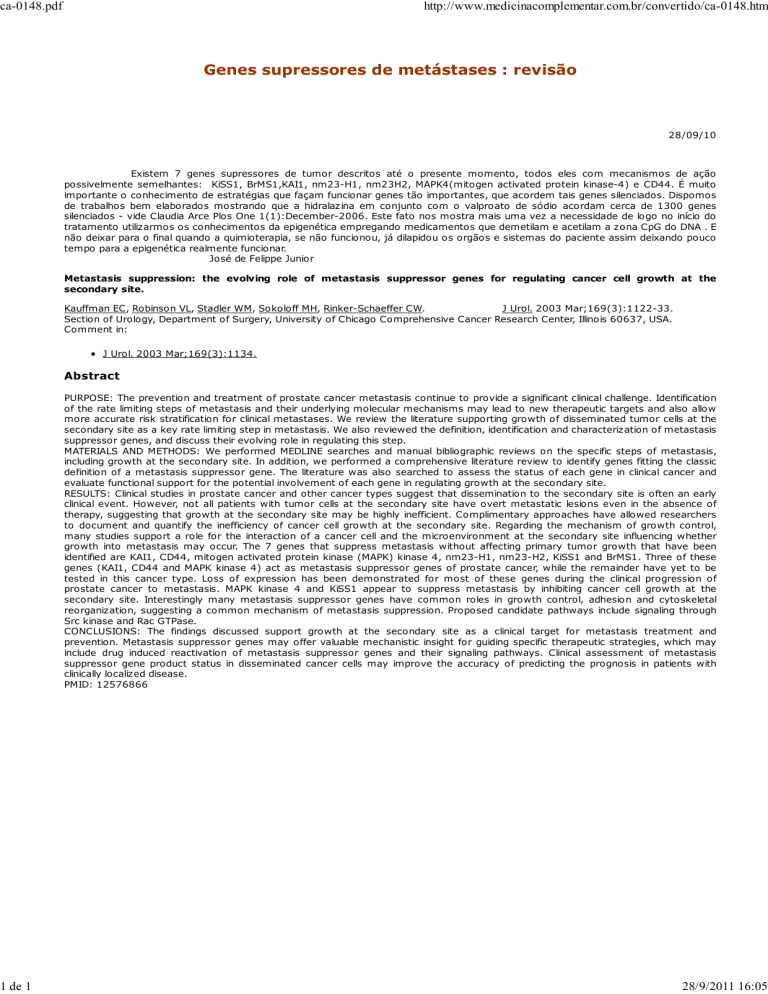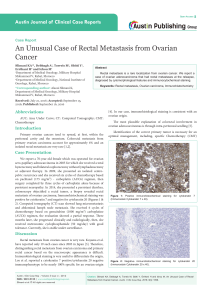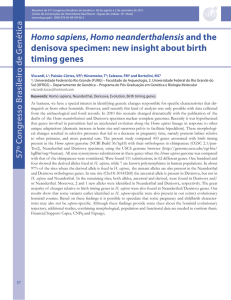
ca-0148.pdf
1 de 1
http://www.medicinacomplementar.com.br/convertido/ca-0148.htm
Genes supressores de metástases : revisão
28/09/10
Existem 7 genes supressores de tumor descritos até o presente momento, todos eles com mecanismos de ação
possivelmente semelhantes: KiSS1, BrMS1,KAI1, nm23-H1, nm23H2, MAPK4(mitogen activated protein kinase-4) e CD44. É muito
importante o conhecimento de estratégias que façam funcionar genes tão importantes, que acordem tais genes silenciados. Dispomos
de trabalhos bem elaborados mostrando que a hidralazina em conjunto com o valproato de sódio acordam cerca de 1300 genes
silenciados - vide Claudia Arce Plos One 1(1):December-2006. Este fato nos mostra mais uma vez a necessidade de logo no início do
tratamento utilizarmos os conhecimentos da epigenética empregando medicamentos que demetilam e acetilam a zona CpG do DNA . E
não deixar para o final quando a quimioterapia, se não funcionou, já dilapidou os orgãos e sistemas do paciente assim deixando pouco
tempo para a epigenética realmente funcionar.
José de Felippe Junior
Metastasis suppression: the evolving role of metastasis suppressor genes for regulating cancer cell growth at the
secondary site.
Kauffman EC, Robinson VL, Stadler WM, Sokoloff MH, Rinker-Schaeffer CW.
J Urol. 2003 Mar;169(3):1122-33.
Section of Urology, Department of Surgery, University of Chicago Comprehensive Cancer Research Center, Illinois 60637, USA.
Comment in:
J Urol. 2003 Mar;169(3):1134.
Abstract
PURPOSE: The prevention and treatment of prostate cancer metastasis continue to provide a significant clinical challenge. Identification
of the rate limiting steps of metastasis and their underlying molecular mechanisms may lead to new therapeutic targets and also allow
more accurate risk stratification for clinical metastases. We review the literature supporting growth of disseminated tumor cells at the
secondary site as a key rate limiting step in metastasis. We also reviewed the definition, identification and characterization of metastasis
suppressor genes, and discuss their evolving role in regulating this step.
MATERIALS AND METHODS: We performed MEDLINE searches and manual bibliographic reviews on the specific steps of metastasis,
including growth at the secondary site. In addition, we performed a comprehensive literature review to identify genes fitting the classic
definition of a metastasis suppressor gene. The literature was also searched to assess the status of each gene in clinical cancer and
evaluate functional support for the potential involvement of each gene in regulating growth at the secondary site.
RESULTS: Clinical studies in prostate cancer and other cancer types suggest that dissemination to the secondary site is often an early
clinical event. However, not all patients with tumor cells at the secondary site have overt metastatic lesions even in the absence of
therapy, suggesting that growth at the secondary site may be highly inefficient. Complimentary approaches have allowed researchers
to document and quantify the inefficiency of cancer cell growth at the secondary site. Regarding the mechanism of growth control,
many studies support a role for the interaction of a cancer cell and the microenvironment at the secondary site influencing whether
growth into metastasis may occur. The 7 genes that suppress metastasis without affecting primary tumor growth that have been
identified are KAI1, CD44, mitogen activated protein kinase (MAPK) kinase 4, nm23-H1, nm23-H2, KiSS1 and BrMS1. Three of these
genes (KAI1, CD44 and MAPK kinase 4) act as metastasis suppressor genes of prostate cancer, while the remainder have yet to be
tested in this cancer type. Loss of expression has been demonstrated for most of these genes during the clinical progression of
prostate cancer to metastasis. MAPK kinase 4 and KiSS1 appear to suppress metastasis by inhibiting cancer cell growth at the
secondary site. Interestingly many metastasis suppressor genes have common roles in growth control, adhesion and cytoskeletal
reorganization, suggesting a common mechanism of metastasis suppression. Proposed candidate pathways include signaling through
Src kinase and Rac GTPase.
CONCLUSIONS: The findings discussed support growth at the secondary site as a clinical target for metastasis treatment and
prevention. Metastasis suppressor genes may offer valuable mechanistic insight for guiding specific therapeutic strategies, which may
include drug induced reactivation of metastasis suppressor genes and their signaling pathways. Clinical assessment of metastasis
suppressor gene product status in disseminated cancer cells may improve the accuracy of predicting the prognosis in patients with
clinically localized disease.
PMID: 12576866
28/9/2011 16:05












